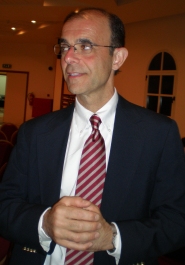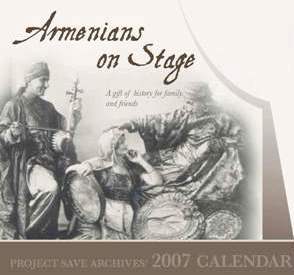
 Joseph E. Malikian, Ph.D. presented archival photographs of the Armenians in the
Joseph E. Malikian, Ph.D. presented archival photographs of the Armenians in the
In the evening of 9 June 2007, Joseph (Joe) Malikian gave a power point presentation (in English) in the Community Hall in Sharjah, UAE, in front of an audience of 40 persons. The event was organized by the newly formed Council of the Armenian Community in the Northern Emirates. Mousheg Bedirian, Chairman of the Council, welcomed the guest and presenting a brief biography, highlighting his career and medical background. Many interesting questions were asked at the end of the presentation, some in the form of comments and follow-ups.
Malikian is a clinical psychologist in practice in
Malikian said that his interest in archival photographs goes back to 5 years. His involvement in this project had a special meaning for him as he was able, through archival photographs, to trace back the history of his own family in
Malikian?s work is closely related to the “Project Save Armenian Photograph Archives”, which was founded by Ruth Thomasian in
Malikian received very positive feedback of his visual representation (150 plus slides) of a story depicting great sadness but also reflecting hope, perseverance and survival, as well as a story about an unprecedented humanitarian relief effort by the Near East Relief at the turn of the 20th century. The attendants seemed to be captivated by the images and intrigued by the impressive campaign and efforts that saved the lives and rehabilitated thousands upon thousands of Armenians and other ethnic groups targeted by the Ottoman government. Particularly impressive were the photos taken from different orphanages (such as the famous one in Alexandropol, in present-day Gyumri). Other examples are
The visual presentation was divided into certain categories with descriptive titles (men, women, children, wedding photos, funeral photos, family photos, church and educational photos, etc.). Some of the photos revealed the contrast between the urban society in
Malikian showed also slides related to humanitarian relief campaign organized in the United States of America during and after the Genocide of 1915-1923, which resulted in raising of about 20 million dollars (a remarkable sum for that time). He showed several advertisement samples as appeared in the newspapers. Many photos were found in the possession of families who used to live in the Ottoman Empire but whose descendants continued their life in the
Malikian admitted that he usually does the presentation in front of Armenian audience, although he acknowledges the need to do it for non-Armenian audience as well.
Comments from the audience: – A member disagreed with Malikian regarding what he (Malikian) described as tension between the Church and the revolutionaries in the pre-Genocide era. “This is what the Turkish propaganda wants us to believe, but in fact the situation was different. Both the Church and the revolutionaries had one common demand: to obtain basic human rights for the Armenian population in the – A member noticed that there were considerable differences in the donation sums in the American newspaper ads of the time. Malikian commented saying that these advertisements were most probably addressing different segments of the population. Therefore they triggered different financial pledges. – An honest person made the following observation: “After seeing all these photos, it is very strange that – Someone from the audience asked about the possibility of looking for archival photos in the possession of individuals or families in the
Dr. Joseph E. Malikian can be reached at
Announcement of the event by the Council of the Armenian Community (PDF format / Armenian and English)
Project Save Armenian Photograph Archives
Project SAVE Armenian Photograph Archives is the premier archive of Armenian photographs in the
Founded by Ruth Thomasian in 1975, Project SAVE Archives' extensive and diverse collection of more than 25,000 photographs, as well as its growing library of oral history audio tapes, depict all aspects of Armenian life in the homeland and Diaspora, from the 1860s to the present day.
Project SAVE strives to increase knowledge of Armenian culture and heritage by encouraging the use of its collection of photographs by the widest possible audience.
Website: http://www.projectsave.org/
Project Save Archives Calendar 2007

